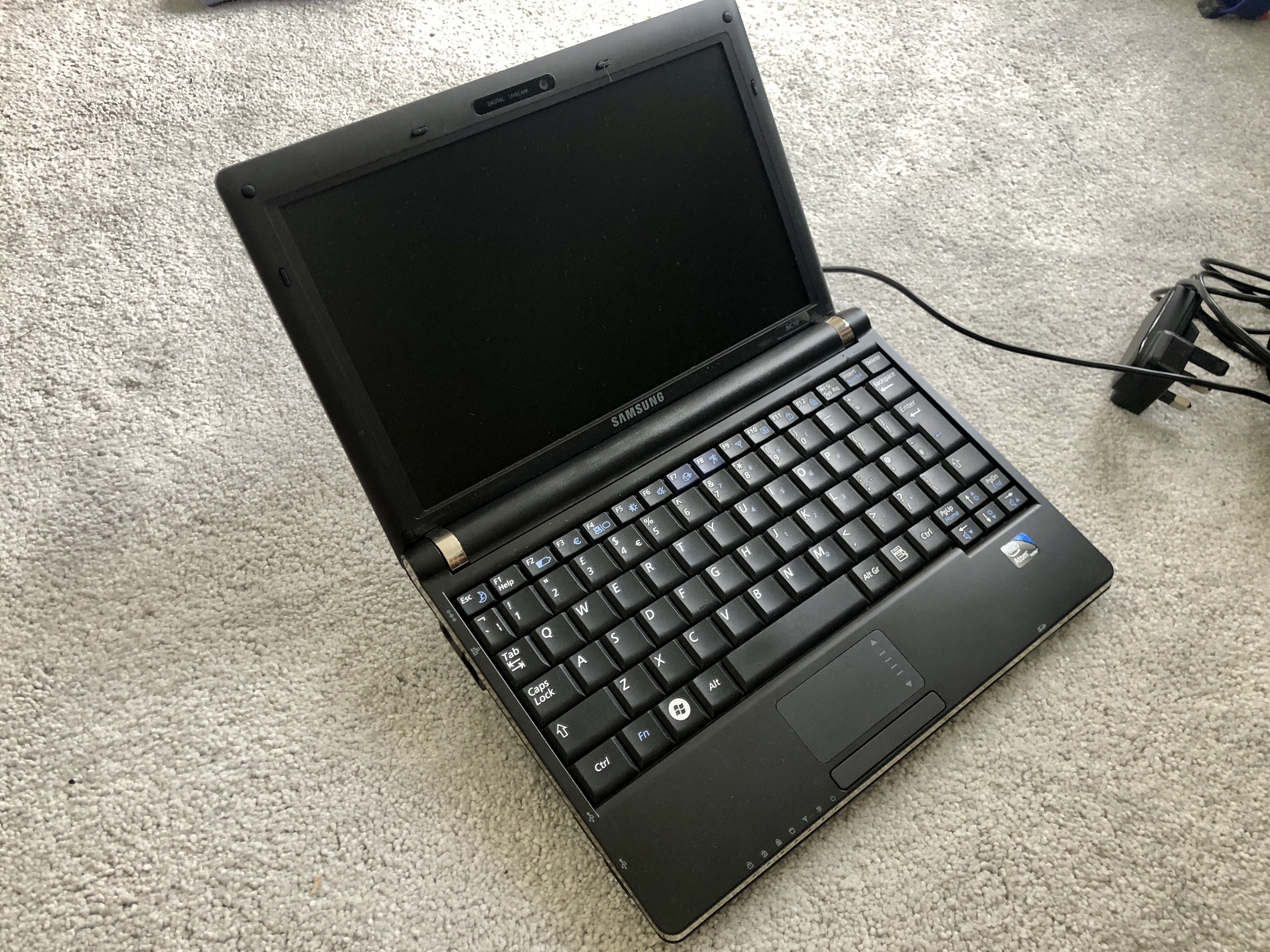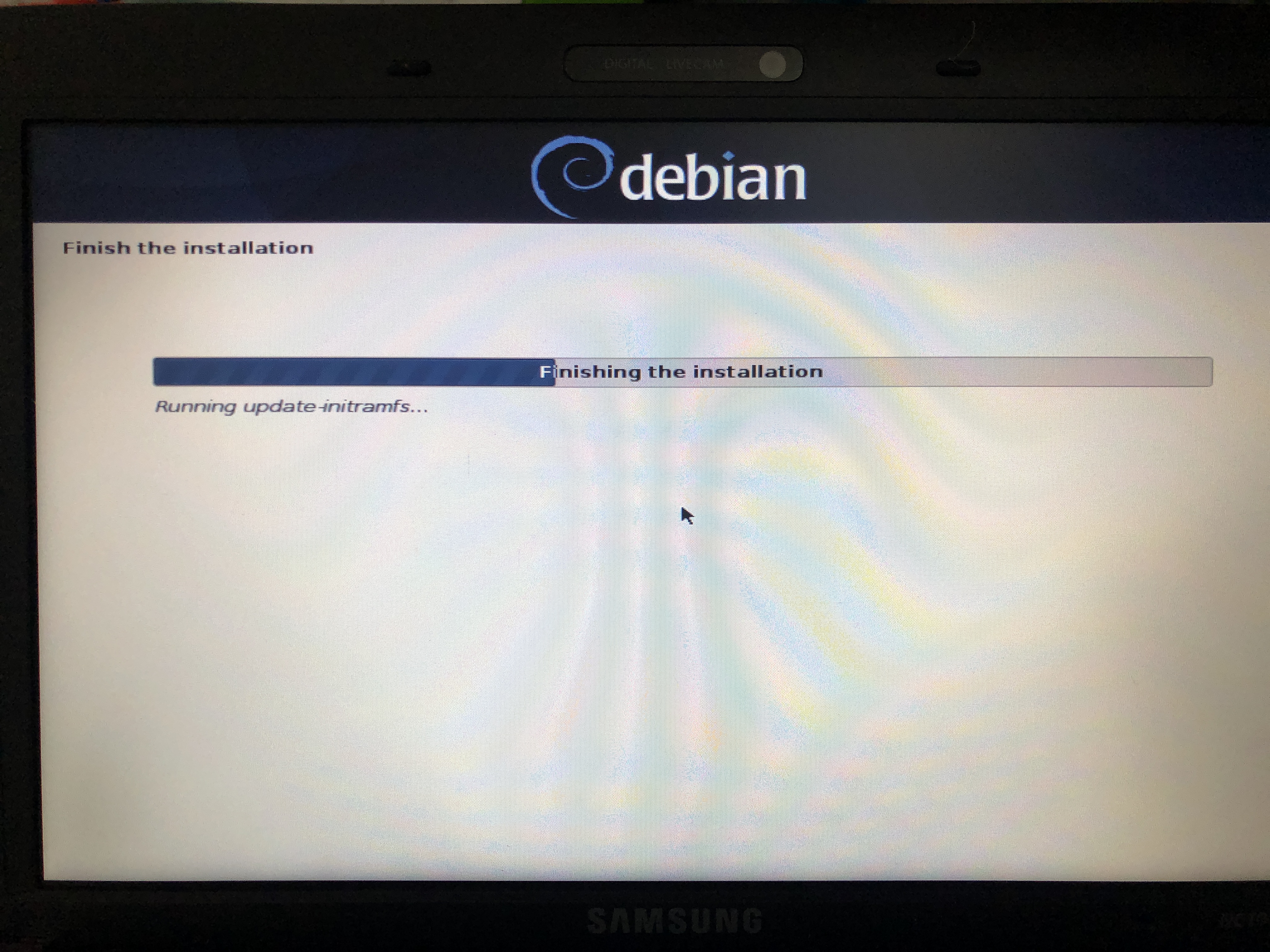Debian 10 on a Samsung NC10

I’ve used iOS and macOS for many years now for my mobile and desktop computing needs and, while I’ve run Linux (mostly Debian) on servers, I have not used it for desktop computing for well over 10 years.
But, recently, I’ve been hankering for a small computer which I can use out-and-about, even though I’m doing much less of that than before. My MacBooks are lovely machines, but they are both quite large and heavy. I also have an old 10" MacBook, but that runs macOS like a dog, and I didn’t fancy trying to turn it into a Linux machine.
And then I remembered that, somewhere in the garage, I had a Samsung NC10 netbook.
I don’t remember exactly how old it is, but I’m guessing around 10 years, perhaps a little longer.
And, as luck would have it, I found it.
So is it useful today?
tl;dr: I’m writing this blogpost on it, so it can at least run vim. But it’s a bit of a dog when it comes to web browsing.
Installing Debian 10 on the Samsung NC10

Creating the USB installer
I install Debian regularly, but I am used to doing it on virtual machines. Mount the ISO, and I’m away.
This time, I needed a USB installer.
Fortunately that’s a relatively simple process: download the ISO, dd it onto a USB stick, and you’re done. The only catch - if indeed it is a catch - was remembering that I needed the i386 version, not amd64.
(I say “simple”; I was doing it on macOS, and did it using the terminal. If there’s a graphical way of doing it, I don’t know it. It was a combination of wget, dd, and the macOS ‘diskutil’ function.)
The installation
After changing the BIOS to boot first from the USB stick, I ran through the graphical installation process to set up Debian with encrypted LVM. Copying the files to the disk was slower than I’m used to, but then I’m dealing with an old machine and an HDD rather than SDD. Frankly, it wasn’t too bad at all, and happened a lot faster than I had expected.
I was pleasantly surprised to note that I didn’t need to faff around with drivers for the Atheros Wi-Fi chipset; this worked out of the box.
Debian 10 on the NC10
It’s… fine.
Tolerable.
That’s about all I can say of it. I was not expecting it to be snappy by any means, and I was right. But it’s far from dreadful either.
#Applications
I haven’t been too adventurous, but then my normal usage of a computer is not too adventurous either.
vim is, unsurprisingly, just fine.
Browsing the web is an exercise in patience. Firefox lags. I haven’t tried another browser but, sadly, this might be a deal breaker. It choked quite badly with nextcloud’s web interface, which pushed me to sync files to the device via the nextcloud desktop client, which isn’t quite what I wanted. Oh well.
I use jitsi for video conferencing, and, while I could load the site in Firefox, and I could give it permissions for my camera and microphone, it seems that actually taking part in a conference was a stretch too far. It actually got further than I had expected, but it doesn’t work.
I haven’t done extensive testing, but some of the sites I happened to be browsing did not work well. Whether that’s down to shoddy site design, or something with the NC10, I’m not sure, but I’m tempted to blame the sites since some sites work just fine.
On the plus side, since I’m using the latest Debian, I don’t need to worry about outdated cipher suites or the like.
Overall, web browsing is enough of a pain that I’m not sure I could see myself using it, and that’s quite an important function.
LibreOffice Writer is not too bad. Again, tolerable. I’ve yet to try it with a complicated document, full of tracked changes, but the initial testing I have done has, again, been better than I expected. It does take a while to open, but that is no surprise, and just requires a bit of patience (and it’s not quite make a cup of tea patience.
nextcloud was as easy to use on Debian as it is on macOS, and, while it is going to take a few hours to sync my files, it’s well under way. nextcloud in the browser, however, was a nightmare, and slow as molasses.
I have yet to set up Thunderbird with PGP, but I don’t expect any problems there.
System bits
With the smaller screen, making some changes to the default ‘panel’ setup was one of the first things to do. I’ve changed it so that both top and bottom panels are hidden all the time, unless I hover over them. That’s fine and, in my view, is the most sensible way to set it up irrespective of screen size, as I don’t se the point of losing the bottom and top of the screen to something with which I need to interact only infrequently.
Configuring systemwide DoH was easy. Much easier than doing it on macOS, since it’s just a config file.
Hardware
I had forgotten just how pleasant it is to type on the keyboard of the NC10, and also just how frustrating the trackpad is. Perhaps I’ve been spoilt by MacBooks, but I find the smaller trackpad close to intolerable.
Conclusion
Right now, I’m impressed. This is a relatively old machine, and it’s doing a lot better than I expected. There are sufficient compromises that I’m not sure I would want to use this full time, but then that’s not on the cards anyway.
It’s a bit larger than I am looking for, but I had a spare afternoon and it was lying around in the garage, so it would have been foolish not to try it.
It has also been enjoyable to use a desktop environment (XFCE) with Debian, after years of using it via terminal.